Lay the Table the 'Proper' Way.
As we head out of this difficult time, we can finally consider entertaining in our homes again. In Australia I have found that entertaining often involves BBQ’s, bring a plate and casual occasions often eating outside. Sometimes I find it can be a lot of fun to create a special table for a more formal dining experience.
As a child I remember my Mum spending the whole day cooking and preparing the table. She donned a long dress and entertained friends with dinner parties.

The trend for table scaping has emerged in the last few years whereby the table is laid with a lavish arrangement of ornaments and other accessories such as crockery and candles. Photos of said table are then shared on social media. In the US, table scaping is so established that it has become a competitive event at county fairs.
This maybe a little over the top for most of us however there are easy ways to create a beautiful table for dinner.
Table linens are fabric goods intended for repeated use and include items such as tablecloths napkins, placemats, table runners and table napkins.
As the name suggests, a tablecloth is a piece of cloth used to cover a dining table before laying out tableware and food. Tablecloths are standard table coverings in formal restaurants and are often white.
From medieval times in Europe, a wealthy household would spread a high quality white linen or cotton cloth on their table in preparation for a feast. Over time, the custom of using a cloth became common for all social classes except for very poor. As eating habits changed a much greater range of table setting styles were developed.

Tablecloths can be used solely to look pretty but they also protect a table from scratches accidental spills or stains. They add a splash of colour, character and design flair to a table, helping to create a theme or set the stage for classy and elegant dining. Spreading a cloth is a great way too to conceal flaws and imperfections or disguise mismatched furniture.
They come in a wide range of colours, styles, designs, and fabric materials that can be coupled with matching or coordinating accessories
While white tablecloths may give that classy appeal to the decor, vibrant and brightly coloured tablecloths can create a striking contrast and charm for your event.

A tablecloth is the main component of the tablescape that never goes out of fashion. With love and care they can last for many years. I have precious cloths in my linen cupboard passed down from my Mum and both Grandmothers.
If yours is a stunningly beautiful table then you may choose not to cover it but consider other items of table linen such as table runners and napkins to enhance both the table aesthetics and overall decor.

The first item to place on the tablecloth is the dinner plate. Position it right in the middle of each setting, equally spaced and with enough room for the rest of the setting.
A table napkin is folded elegantly and placed them in the middle of the dinner plate. Napkin rings can add some extra personality are coming back into vogue. The napkin with ring sits on the outside of the forks.
Table napkins are a small piece of table linen added to the individual place setting that used to wipe the hands and mouth, blot spills and to cover the lap to protect clothing. They are one of the cheapest and easiest ways to transform a table from the ordinary to special and you can even make your own.

Paper napkins will disintegrate after a few quick wipes, but your cloth napkin can stand up to the messiest meal every time. Once you have a set or two in your cupboard, as long as stains are treated quickly, they will be used for many dinner parties to come.
The history of napkins overlaps with that of tablecloths. In certain periods, especially during the time of the ancient Roman Empire, fabrics slightly smaller than the tablecloth, called ‘mappae’ to mean ‘kin’ to the tablecloth were used to clean themselves up during and after meals.
After the fall of the Roman Empire the use of napkins disappeared, and people used whatever was available to clean up their mess.
Between the 15th and 16th centuries, the elite brought back napkins using them as a status symbol.
In the 17th century, forks were introduced meaning people ate less sloppily, and the size of napkins was drastically reduced. While the ancient napkins were about the size of the tablecloths, the standard napkin was brought down to between 45 and 60cm square.

Over the years that followed, the table napkin established itself as an indispensable part of a formal table setup. ‘Proper’ table manners always included etiquette around use of napkins before, during, and after meals.
To fold a napkin into a rectangle first open the entire napkin and iron if necessary. Fold in half to form a rectangle, fold that rectangle to form a square, and fold that square into a smaller rectangle.
Place in the centre of the plate with the folded side to the right. For celebratory meals, it's fun to fold napkins into every decorative shape you can dream of. I will let you explore that further on You Tube.

So, to continue, with the dinner plate in the centre of the setting (a charger plate can be placed beneath the dinner plate) the dinner fork goes to the left of the dinner plate and the salad fork goes to the left of the dinner fork. The cutlery is placed in the order that it will be used starting from the outside.
Place the knife to the right of the dinner plate and then set the soup spoon to the right of the knife.
Knife blades should be facing towards the plate and fork prongs facing upwards.
Lay dessert fork and spoon above the place setting with the fork pointing to the right and the spoon above the fork pointing to the left.
The bread plate should be placed above and to the left of the dinner and salad plate. The butter knife can be placed horizontally on the bread plate.
If serving salad and soup, place the salad plate on top of the dinner plate and the soup bowl on top of the salad plate.
Water and wine glasses go to the right of the place setting just above the table knife. The water glass should be closest to the guest and the red wine glass goes just behind the white wine glass.
The coffee cup and saucer can be set below the glasses.
Maybe add a place card above the dessert spoon. Write the guest's name on both sides so they can find their seat and the guests on the other side of the table will know who they are talking to.

I’ve read that when the meal is over, the host will signal the end of the meal by placing his or her napkin on the table. Apparently, you should follow suit by placing your napkin neatly on the table to the left of your dinner plate, with no soiled areas showing. I have probably got the etiquette all wrong for so long!
The most important thing, all said and done is to enjoy both the preparation and special mealtimes with the family and friends that we have all missed so much.
Whether you are looking for fun or formal table linen find a great selection here.





Leave a comment